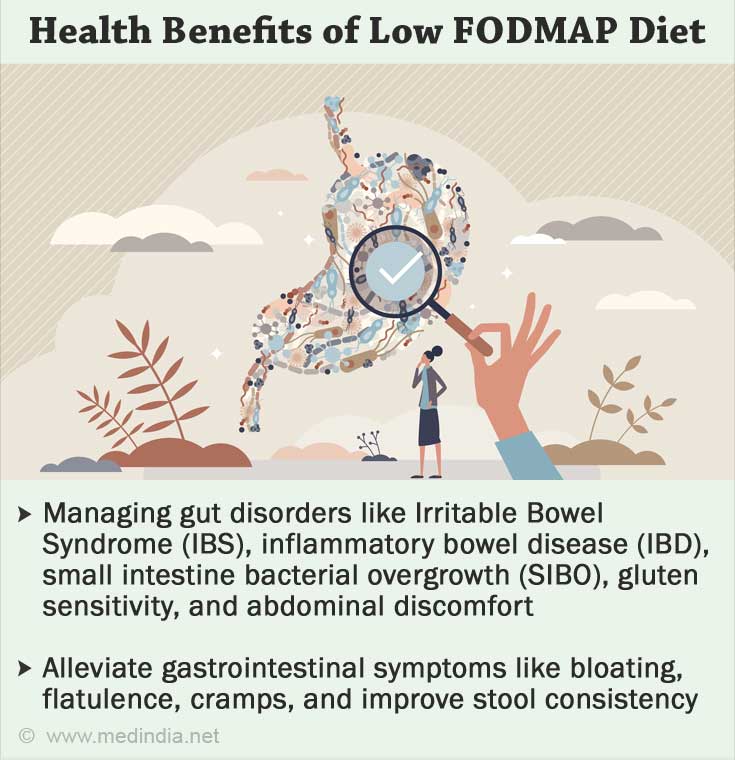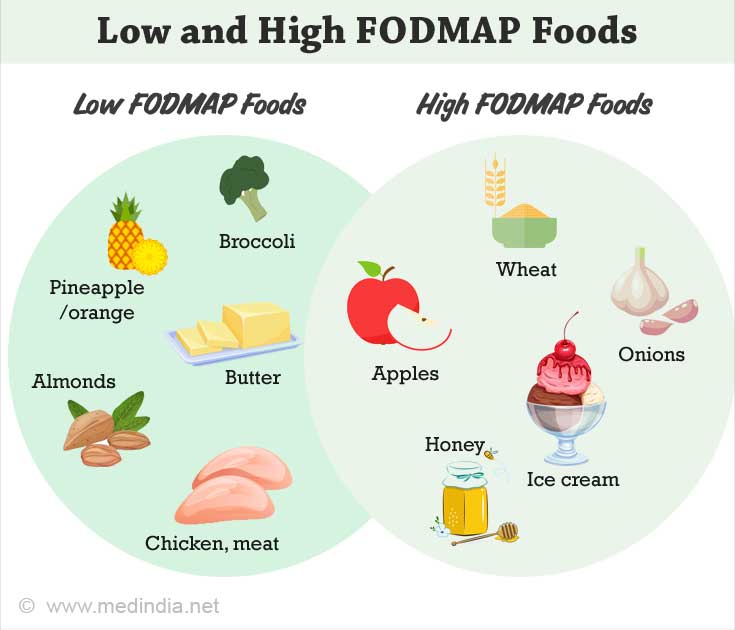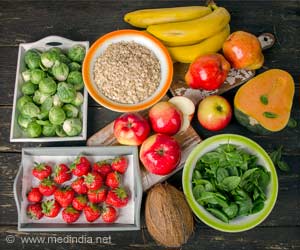- Bellini, M., Tonarelli, S., Nagy, A. G., Pancetti, A., Costa, F., Ricchiuti, A., de Bortoli, N., Mosca, M., Marchi, S., &Rossi, A. (2020). Low FODMAP diet: Evidence, doubts, and hopes.Nutrients, 12(1), 148 - (https://doi.org/10.3390/nu12010148)
- FODMAP Food List - (https://www.ibsdiets.org/fodmap-diet/fodmap-food-list/)
- What are FODMAPs? - (https://www.monashfodmap.com/about-fodmap-and-ibs/)
- Monash low FODMAP recipe index - (https://www.monashfodmap.com/recipe/monash-low-fodmap-recipe-index/)
- Whelan, K., Martin, L. D., Staudacher, H. M., &Lomer, M. C. (2018). The low FODMAP diet in the management of irritable bowel syndrome: An evidence-based review of FODMAP restriction, reintroduction and personalisation in clinical practice.Journal of Human Nutrition and Dietetics, 31(2), 239–255 - (https://doi.org/10.1111/jhn.12530)
- FODMAPs are spread across different food groups such as cereals, legumes, fruits, vegetables, dairy products, and sweeteners. Foods containing FODMAPs may potentially trigger symptoms among patients diagnosed with Irritable Bowel Syndrome (IBS). When foods containing FODMAPs are consumed there is increased water content in the small bowel, increased production of gas and short-chain fatty acids (SCFA), thereby kickstarting adverse abdominal symptoms. Hence a diet that is low in FODMAPs will prevent the mentioned outcomes from occurring. - (https://doi.org/10.1111/jhn.12530)
- FODMAP Diet: What You Need to Know - (https://www.hopkinsmedicine.org/health/wellness-and-prevention/fodmap-diet-what-you-need-to-know)
What is FODMAP Diet?
FODMAPs, acronym of Fermentable, Oligo-, Di-, Mono-saccharides, And Polyols, belong to a class of carbohydrates. FODMAPs are not well absorbed in the small intestine, and their chain length contains about one to ten sugars.
From the acronym FODMAP, Oligosaccharides include fructans and galactooligosaccharides (GOS), Disaccharides are lactose, Monosaccharides are fructose, and Polyols include sorbitol and mannitol.
The FODMAP diet has three phases, namely, FODMAP restriction, reintroduction, and personalization phase. High FODMAP foods are restricted in the first phase. Once the symptoms have subsided, the second phase begins with reintroducing FODMAP foods to identify the trigger foods. Finally, the last phase includes personalization based on the individual’s tolerance.
FODMAPs are spread across different food groups such as cereals, legumes, fruits, vegetables, dairy products, and sweeteners. Foods containing FODMAPs may potentially aggravate symptoms among patients diagnosed with Irritable Bowel Syndrome (IBS).
When foods containing FODMAPs are consumed, there is an increase of water content in the small bowel, increased production of gas, and short-chain fatty acids (SCFAs), thereby kick starting adverse abdominal symptoms. Hence a diet low in FODMAPs helps relieve the discomforting abdominal symptoms.
What are the Health Benefits of Low FODMAP Diet?
Research has revealed several health benefits with a diet low in FODMAPs. Low FODMAP diet is found to be fruitful in managing gut disorders like IBS, Inflammatory Bowel Disease (IBD) and Small Intestinal Bacterial Overgrowth (SIBO), gluten sensitivity, and abdominal discomfort.

A low FODMAP diet is vastly used as a helpful tool in IBS. Several studies have reported positive outcomes in patients with IBS following a low FODMAP diet. Not restricting to IBS, low FODMAP foods were also beneficial in IBD. A study revealed that a low FODMAP diet promoted satisfactory relief from symptoms and reduced the severity of functional-gastrointestinal symptoms in IBD.
Choosing foods low in FODMAPs will reduce gas and water production and alleviate gastrointestinal symptoms such as bloating, flatulence, cramps, and improve stool consistency. It also turns down the abnormally high levels of bacteria in the intestine.
What are the Side Effects of Low FODMAP Diet?
Microbial dysbiosis is the biggest concern with a low FODMAP diet. The presence of natural prebiotics is reduced with a diet low in FODMAPs, thereby causing changes in the intestinal microflora. Lack of prebiotics turns down the production of short-chain fatty acids.
FODMAP restriction will reduce osmotic fluid content potentially leading to constipation. A low FODMAP diet is reported to be low in fiber intake, which can also be one of the causative factors for constipation.
But there are also studies proving that there is no difference in the fiber content of low FODMAP and habitual diet. A study where IBS patients were provided high-fiber foods that ferment lightly, like rice and oats bran, showed improved stool consistency.
Restricting FODMAPs poses a risk for nutritional deficiencies. Reduced fructans in diet will decrease the presence of carbohydrates, fiber, and iron intake. Excluding several types of vegetables leads to a reduced intake of powerful antioxidants like flavonoids, vitamin C, carotenoids, anthocyanins, and phenolic acids.
Calcium deficiency may also occur when dairy products, the main source of the nutrient, are restricted. Overall, calories in a low FODMAP diet are reduced, leading to weight loss. Some studies have also shown reduced intake of proteins with FODMAP restricted diet.
A low FODMAP diet should be avoided in patients with eating disorders as it might influence their work and social lives.
A well-planned low FODMAP diet will pave the way to reaping the maximum benefits of the diet.
FODMAP DIET — Foods Included and Avoided
Foods containing high amounts of FODMAPs are excluded from the menu. Following are the foods classified based on food groups holding the green (low FODMAP) and red (high FODMAP) sign for inclusion.

|
FOOD GROUPS |
LOW FODMAP FOODS |
HIGH FODMAP FOODS |
|
Cereals and cereal products |
Sorghum and other millets, cornflakes, oats, buckwheat, cornflour, rice, quinoa, gluten-free breads, cakes made from oats/corn/rice, and bread made using corn/rice/spelt sourdough |
Wheat and products made using wheat, barley, couscous, muesli, semolina, rye |
|
Pulses and legumes |
Black beans, chickpeas, pulses in small amounts |
Black-eyed peas, kidney beans, lima beans, mung beans, soya beans |
|
Vegetables |
Broccoli, Brussel sprouts, cabbage, carrots, eggplant, green beans, lady’s finger, potato, tomato, pumpkin, bell peppers, cucumber |
Onions, garlic, asparagus, fresh beetroot, cauliflower, fermented cabbage, pickled vegetables, butter beans, broad beans, shallots |
|
Fruits |
Kiwifruit, blueberries, grapes, guava, orange, papaya, pineapple, strawberry |
Apple, avocado, banana, mango, pomegranate, pears, custard apple, unripe guava, watermelon, plums, raisins, cherries |
|
Milk and its products |
Milk (almond, rice, lactose-free), butter, cottage cheese, cheese (parmesan, mozzarella, cheddar) |
Milk (cow, goat, sheep, and evaporated), buttermilk, cream cheese, ice cream, yogurt, kefir (fermented milk drink) |
|
Nuts and seeds |
Almonds, walnuts, pine nuts, peanuts, most seeds like chia, dill, poppy, pumpkin, sunflower, sesame, and flax seeds |
Pistachios, cashew |
|
Meat, poultry, and seafood |
Chicken, egg, lamb, pork, turkey, fresh fishes like salmon, trout, tuna, cod, crab, lobster, oysters, shrimps, and prawns |
Sausages, certain processed meat products (look for ingredients) |
|
Condiments, spreads, and sweeteners |
Mustard, mayonnaise, barbeque sauce, soy sauce, apple cider vinegar, tamarind paste, peanut butter, almond butter, strawberry jam, dark chocolate, stevia, glucose, aspartame, marmalade, and maple syrup |
Cream-based pasta sauce, mixed berries jam, high fructose corn syrup (HFCS), honey |
Recipes
Though there seems to be a long list of foods to be avoided in a low FODMAP diet, there are several interesting must-try recipes out there. Swap the muesli or usual breakfast cereals with the following: quinoa pudding with low FODMAP fruits, buckwheat crepes, tortillas, maple granola, millet porridge, carrot fritters, and spinach omelet.
Include the following main dishes like chicken noodles, chicken soup, chicken curry, roasted sweet potato and rice, avial curry, millet salad, vegetable-chickpea soup, and stuffed capsicum.
Low FODMAP sides include carrot-pepita dip, pumpkin hummus, carrot-cumin dip, tomato chutney, and broccoli salad with lactose-free yogurt.
Desserts are everybody’s favorite and here are a few low FODMAP-friendly desserts: chocolate-peanut butter smoothie, chocolate pudding, almond muffins, pumpkin bread, rice pudding, tahini chocolate chip cookie, and many more.
FODMAPs are rolled out across several foods, but that does not limit oneself from eating nutritious and healthy. A rightly planned low FODMAP diet will not only help alleviate adverse gastrointestinal symptoms but also guide in preventing potential side effects of the diet.











